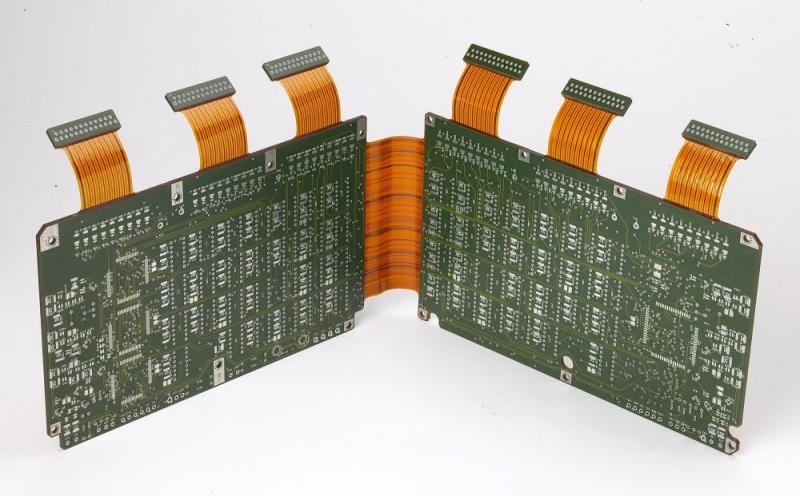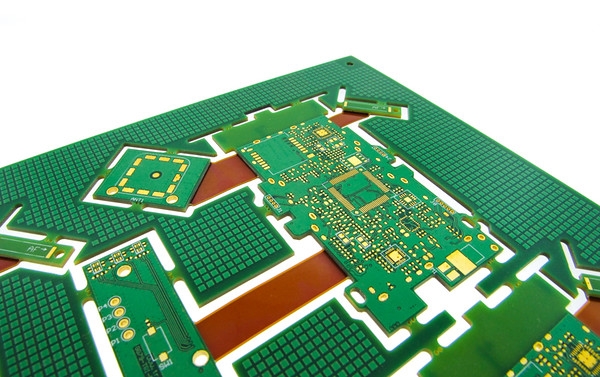A Rigid-Flex PCB, short for Rigid-Flexible Printed Circuit Board, is a specialized type of printed circuit board that combines both rigid and flexible board materials within a single design. This unique construction allows the PCB to bend or flex to a certain degree while maintaining the structural integrity and electrical connections of the rigid portions. Rigid-flex PCBs are commonly used in applications where space constraints, reliability, and complex geometries are critical, such as in aerospace, medical devices, and consumer electronics. Rigid Flex PCB Cost Comparison

Cost analysis in PCB design and production is essential for making informed decisions that balance performance, functionality, and affordability. It allows designers and manufacturers to optimize their processes, select appropriate materials, and meet budgetary constraints while delivering high-quality printed circuit boards.
Components of Cost in Rigid-Flex PCB Production
1. Material Costs
1) Rigid Sections:
The expenditure is associated with the selection of rigid materials like FR-4 or alternative substrates employed in the rigid segments of the PCB. Costs related to copper foil, encompass considerations of thickness and surface finish options for the rigid sections.
2) Flexible Sections:
The financial outlay is connected to flexible materials such as polyimide (PI) or polyester (PET), which are used in the flexible regions of the PCB. Expenses associated with copper foil, including considerations for thickness and surface finish options within the flexible sections.
3) Adhesives and Other Materials:
The monetary investment in adhesives employed is employed to bond the rigid and flexible layers together. Costs are linked to materials like overlay or solder masks, which are used for protection and insulation purposes. Additional expenses, such as those incurred for stiffeners or reinforcement materials, are designed to enhance the rigidity or durability of the flexible sections.
2. Manufacturing Processes
1) Lamination
Costs connected to the lamination process, encompassing expenses associated with equipment, labor, and energy consumption. Outlays for maintaining precise control over temperature and pressure during lamination to ensure the quality of the final product.
2) Drilling:
Financial considerations encompass drilling costs, which include expenses for drill bits, maintenance of drilling equipment, and labor. The impact of drilling complexity on costs, particularly in the context of precision drilling required for holes in rigid-flex PCBs.
3) Plating:
Expenditures related to the electroplating process, which involves adding copper to the PCB's circuitry. Costs associated with chemical solutions, electricity consumption, and labor required during the plating process.
4) Component Placement and Soldering:
Costs are tied to both automated and manual component placement equipment. Soldering expenses, encompassing the costs of solder paste, reflow ovens, and skilled labor for soldering surface mount components. Potential expenses associated with wave soldering or selective soldering for through-hole components within the rigid sections.
3. Design Complexity
1) Layers Involved:
The financial implications of the number of layers incorporated into the PCB design, directly affect manufacturing complexity and costs. A higher number of layers typically translates into increased material and processing expenses. The additional costs associated with multilayer rigid-flex PCBs, including extra lamination steps and the need for more precise drilling and plating processes.
2) Size and Geometry of the Board:
Costs linked to larger and more intricate board geometries, necessitating specialized manufacturing equipment and processes, potentially leading to higher expenses. Considerations for irregular or complex shapes, which may result in increased material wastage during the manufacturing process.
3) Signal Integrity Considerations:
The financial impact of stringent signal integrity requirements within the PCB design, such as impedance control, may entail additional costs related to testing and quality assurance. Costs associated with specialized materials and design practices required for high-speed or RF (radio frequency) applications, influence both
material selection and manufacturing processes.
Comparative Costs with Alternative Technologies
1. Traditional Rigid PCBs
1) Cost Factors:
Material costs, encompassing rigid substrate and copper foil expenses. Manufacturing processes, including drilling, plating, and soldering. Complexity of the PCB design, such as layers and geometry. Size and configuration of the rigid PCB.
Benefits and Limitations:
2) Benefits:
A well-established technology with a mature supply chain. Generally, lower material costs compared to certain alternatives. Suitable for conventional, non-flexible applications.
3) Limitations:
Limited flexibility and adaptability, especially for complex or non-standard shapes. Potential need for extra connectors and cables for flexible connections. Not optimal for applications involving significant bending or space constraints.
2. Pure Flexible PCBs
1) Cost Factors:
Material costs, encompassing flexible substrates like polyimide (PI) or polyester (PET) and copper foil. Specialized manufacturing processes tailored to flex circuits. Complexity of the flexible PCB design, including layers and geometry.
2) Benefits and Limitations:
Benefits:
- Exceptional flexibility and adaptability to irregular shapes and bending requirements.
- Reduced reliance on connectors and cables, potentially resulting in cost savings.
Suited for applications with space constraints and dynamic movement.
Limitations:
- Generally higher material costs compared to rigid PCBs.
- Potential for increased expenses due to specialized manufacturing processes.
- Limited incorporation of rigid sections for component mounting.
3. Newer Technological Alternatives
1) Embedded Components:
- Cost Factors: The inclusion of embedded components can contribute to material costs and complexity.
- Benefits: Reduced PCB size, fewer interconnects, and enhanced reliability.
- Limitations: Initial costs associated with embedding components, as well as specialized assembly processes.
2) 3D-Printed Electronics:
- Cost Factors: Material costs, investment in 3D printing equipment, and post-processing expenses.
- Benefits: Swift prototyping, the capacity to realize complex geometries, and - minimized material waste.
-Limitations: Restricted material choices, constraints on resolution, and additional costs linked to post-processing.
3) Organic Electronics:
- Cost Factors: Material costs for organic substrates, as well as expenses associated with specialized manufacturing.
- Benefits: Enhanced flexibility, reduced weight, and the potential for cost-effective production.
- Limitations: Limited maturity in the field, along with the potential for higher material costs when employing advanced organic materials.
4) Comparative Analysis:
Traditional rigid PCBs are typically cost-effective for standard applications but lack flexibility. Pure flexible PCBs offer excellent flexibility but tend to involve higher material and manufacturing expenses.
Newer alternatives, such as embedded components, 3D-printed electronics, and organic electronics, provide unique advantages but may require higher initial investments or encounter limitations related to materials and processes.
The choice among these technologies hinges on specific application requirements, including flexibility, budgetary constraints, and desired features. Comprehensive cost analysis should encompass the entire lifecycle, considering aspects like production, maintenance, and overall performance. Rigid Flex PCB Cost Comparison

Factors Influencing the Total Cost of Ownership (TCO) for Rigid-Flex PCBs
1. Reliability & Longevity
1) Considerations for Wear and Tear:
Evaluating the PCB's long-term durability, including its ability to withstand mechanical stress, bending, and environmental conditions. Assessing the potential impact of wear and tear on the PCB's performance, which may necessitate maintenance or replacement, incurring additional costs.
2) Maintenance Costs:
Accounting for the expenses related to regular maintenance, inspections, and repairs aimed at ensuring the ongoing reliability of the rigid-flex PCB. Budgeting for the replacement of components or materials that may become damaged or deteriorate over time.
2. Integration Costs
1) Compatibility with Existing Systems:
Examining the compatibility of the rigid-flex PCB with pre-existing systems and components, which might require additional investments in adaptors, converters, or interface adjustments. Factoring in the costs associated with making the PCB compatible with legacy hardware and software to ensure seamless integration.
2) Re-design Expenses for Integration:
Considering the financial implications of redesigning or modifying the PCB layout to accommodate changes in the overall system or to facilitate the integration of new components. Allocating resources for testing and validation to verify the functionality and coherence of the redesigned PCB within the system, may involve additional expenses.
3. Operational Efficiency
1) Power Consumption:
Assessing the power efficiency of the rigid-flex PCB, including an analysis of energy consumption by active components and standby power usage. Estimating the cumulative energy costs associated with operating the PCB throughout its operational lifespan.
2) Signal Efficiency:
Evaluating the effectiveness of signal transmission and reception within the PCB, taking into account factors such as signal loss, noise, and interference. Budgeting for measures to address signal degradation, including potential expenses for signal boosters or error correction mechanisms.
3) Heat Generation and Dissipation:
Gauging the extent of heat generated during PCB operation and the effectiveness of mechanisms for heat dissipation. Considering the costs associated with implementing cooling solutions, such as heat sinks, fans, or other thermal management techniques, to maintain safe operating temperatures.
CONCLUSION
In summary, the field of PCB design and manufacturing, particularly in the context of Rigid-Flex PCB Cost Comparison, is shaped by a multitude of intricate factors that influence both initial expenses and the enduring Total Cost of Ownership (TCO). These factors encompass materials, manufacturing procedures, intricate design aspects, and the exploration of alternative technologies.
To make well-informed decisions within the domain of rigid-flex PCBs, it is of utmost importance to conduct thorough and precise cost analyses. This entails a comprehensive examination of both immediate production costs and the far-reaching consequences. By achieving a harmonious equilibrium between functionality, durability, and fiscal prudence, stakeholders can fully unlock the potential of rigid-flex PCB technology while maximizing their investments.










 2023-10-23
2023-10-23
 BEST
BEST

.png)
.png)
.png)
.png)

.png)

